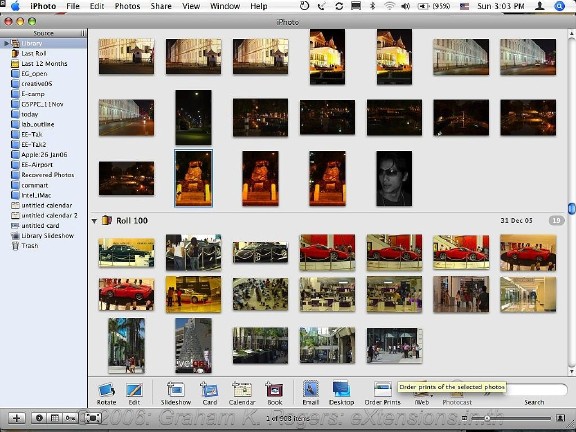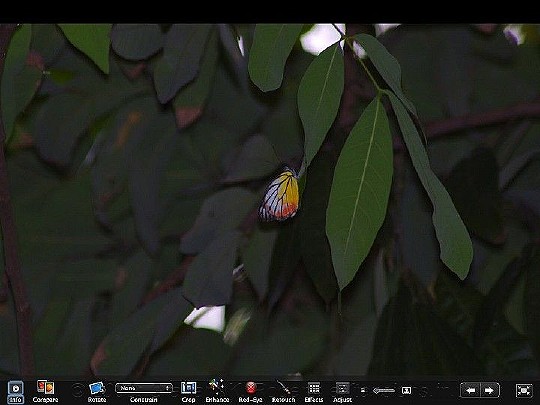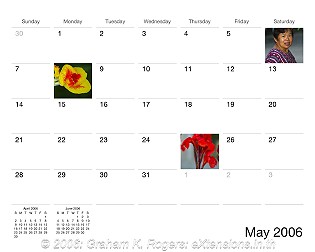
eXtensions
|
iPhoto: Easy to use and more functions |
iPhoto first appeared around the beginning of 2003. It was useful for downloading images from digital cameras automatically, storing them and making basic editing changes. We could export and resize images to make a basic webpage or a slideshow of a group of images and, if you lived in the USA, to have a book printed from your shots. Storage at that time was limited to about 2,000 images.

The storage has increased: first to 25,000 images and now to 250,000. It also became possible in an earlier iPhoto to download mpeg files from cameras.
To the editing facility was first added "adjust", a series of sliders to alter the image (e.g. exposure, sharpness). In the latest version of iPhoto there is also an "Effects" panel like the panels in PhotoBooth; among them are sepia, fade, matte, edge blur. A further improvement to the editing process is the new ability to be able to edit images side by side. In addition this can be done full screen -- all the interface clutter is gone.

Organisation of images and the way data appears while scrolling, for example, suggest major changes under the interface some of which integrate with Spotlight searches and also with the other components of iLife.
Unchanged are the export to image, to web pages and to QuickTime, although these have been moved back to the Export menu from Share where they were for iPhoto 5. Also moved is the Slideshow facility. This is no longer in a menu but is accessed by a button in the toolbar beneath the library window. The slideshow works the same way and integrates with the iTunes library. It can export small, medium or large .mov files.
The Book is also available as an export function as before. Now added are card and calendar. There is also a button marked "Order Prints". In a similar way to making a book with iPhoto, and other appplications (iLife and iWorks) it is easy to make a personalised card from templates provided, or to make a calendar.
The card uses one image. The card button is pressed and a template selected. On the inner page, space is available to write a message to the intended recipient.
With the calendar, it is better to select images first then click on the calendar button. iPhoto offers a choice of templates. Once selected, images are dragged from the drawer on the left into the calendar; or a user may use "autoflow" -- this is making it too easy -- and the calendar is assembled.

|

|
It took me less than a minute to make a card and under five for the calendar.
For those where this is available, the next step is to press "Buy Calendar". Like the book or card, this is only an option in certain areas. Seventeen countries can access this service: only Japan in Asia.
I question why local Apple offices (and I do not aim this specifically at the Thailand operation) have not come up with solutions that allow all users to access quality printing direct from iPhoto.
What I do as a workaround is to save the book or calendar or card as a pdf then convert each page of that file to an image. This can be printed out if high quality is desired. A jpg of a calendar page was 110Kb and a tiff of the same page, ready for printing was 34MB.
The toolbar has an email icon which makes for a single-click operation to send a message that includes one or more images. There are four levels of image size to choose from (actual size down to small). All we have to do is enter the address of a recipient. Although Apple's Mail is my default, we can select AOL, Eudora or Microsoft Entourage.
Adjacent to the Mail icon is Desktop and it is possible to change the desktop picture directly from iPhoto. Images from iPhoto may also be used as screen savers.
There are two new additions: Photocast and iWeb. Members of .Mac can send image selections to their .Mac accounts. Those subscribed will see the same album in their iPhoto libraries. Anyone who uses RSS can see the album, including PC owners.
iWeb is the newest component of iLife. In a similar way to automatic page creation in other sections, iWeb will create a blog or album page from photographs. These may either be sent direclty to a .Mac account or saved and sent to a web site in the normal way.
iPhoto has become not just a simple editor and organiser but software that integrates images with sound, and with newer web technologies, also allowing other more consumer-oriented output. It comes free with new Macs, or is one part of iLife (3,990 baht). Some of the functions are limited for those in Thailand, or those without a .Mac account.

For further information, e-mail to Graham K. Rogers.
Back to
eXtensions
To
eXtensions: 2004-05
To
eXtensions: Year Two
To
eXtensions: Year One
To
eXtensions: Book Reviews
Back to homepage